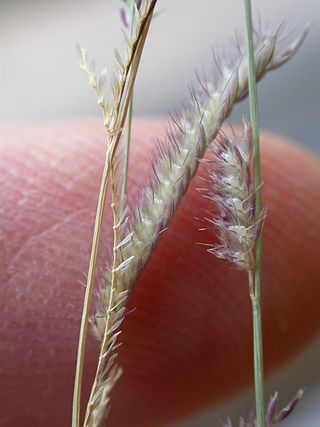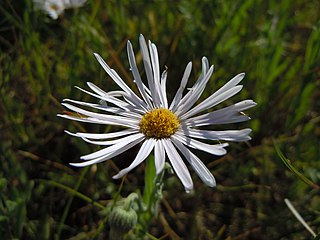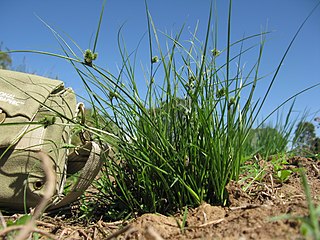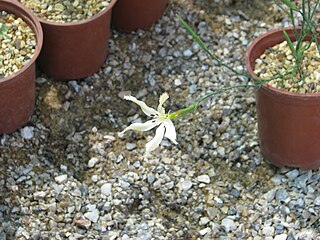
Elymus repens, commonly known as couch grass, is a very common perennial species of grass native to most of Europe, Asia, the Arctic biome, and northwest Africa. It has been brought into other mild northern climates for forage or erosion control, but is often considered a weed.

Echinocereus reichenbachii is a perennial plant and shrub in the cactus family. The species is native to the Chihuahuan Desert and parts of northern Mexico and the southern United States, where they grow at elevations up to 1,500 meters (4,900 ft). This cactus earned the Royal Horticultural Society's Award of Garden Merit.

Sporobolus is a nearly cosmopolitan genus of plants in the grass family. The name Sporobolus means "seed-thrower", and is derived from Ancient Greek word σπόρος (spóros), meaning "seed", and the root of βάλλειν (bállein) "to throw", referring to the dispersion of seeds. Members of the genus are usually called dropseeds or sacaton grasses. They are typical prairie and savanna plants, occurring in other types of open habitat in warmer climates. At least one species is threatened with extinction, and another is extinct.

Stipa parishii, formerly classified as Achnatherum parishii, is a species of grass known by the common name Parish's needlegrass. The Jepson Manual 2nd edition (2012) reclassified the plant as Stipa parishii var. parishii.

Aristida californica is a species of grass known by the common names California threeawn and Mojave threeawn. It is native to the Mojave Deserts and Sonoran of northern Mexico and California and Arizona.

Cynosurus echinatus is a species of grass known by the common names bristly dogstail grass, rough dog's-tail and hedgehog dogtail. It is native to southern Europe, and it is known in the Americas and Australia as an introduced species and sometimes a noxious weed. An herbicide-resistant strain can be found growing as a weed in canola and wheat fields in Chile. This is an annual grass growing 10 to 50 centimeters tall. The inflorescence is a rounded or oval cluster or series of clusters of spikelets. The fertile spikelet has an awn up to a centimeter long. The awns clumped closely together into a tuft gives the inflorescence its bristly, hairy appearance.

Astelia is a genus of flowering plants in the recently named family Asteliaceae. They are rhizomatous tufted perennials native to various islands in the Pacific, Indian, and South Atlantic Oceans, as well as to Australia and to the southernmost tip of South America. A significant number of the known species are endemic to New Zealand. The species generally grow in forests, swamps and amongst low alpine vegetation; occasionally they are epiphytic.

Dianella revoluta, commonly known as blueberry lily, blue flax-lily, or black-anther flax-lily, a species of flowering plant in the family Asphodelaceae and is endemic to, and widespread in Australia. It is a tufted, perennial herb with grass-like leaves and up to nine blue or violet flowers with six tepals, and stamens with bright yellow filaments and pale brown to almost black anthers.

Echinopogon is a genus of grasses native to Australia, New Guinea, Indonesia, and New Zealand. They are known commonly as hedgehog grasses.

Taractrocera papyria, the white-banded grass-dart, is a butterfly of the family Hesperiidae. It is found in the Australian Capital Territory, New South Wales, Queensland, South Australia, Tasmania, Victoria and Western Australia.

Bouteloua barbata is a species of grass known by the common name six-weeks grama native to North America.

Poa poiformis, commonly known as coast tussock-grass or blue tussock-grass, is a densely tufted, erect, perennial tussock grass, with distinctive blue-green leaves, that grows to about 1 m in height. Its inflorescences are arranged in a dense panicle up to 30 cm long. It is native to coastal southern Australia where it occurs along ocean foreshores, estuaries, dunes and cliffs. P. poiformis is also found on Kangaroo Island and Lord Howe Island.

Paspalum setaceum is a species of grass known by several common names, including thin paspalum. It is native to the Americas, where it can be found in the eastern and central United States, Ontario in Canada, Mexico, Central America, and the Caribbean. It can be found in other areas of the world as an introduced, and often invasive, species, including many Pacific Islands. It is a weed of lawns and turf.

Patersonia sericea, commonly known as purple flag or silky purple-flag is a species of plant in the iris family Iridaceae and is endemic to eastern Australia. It is a densely-tufted perennial herb with linear, sword-shaped leaves, broadly egg-shaped, bluish-violet tepals and an oval capsule.

Erigeron caespitosus is a North American species of flowering plants in the family Asteraceae known by the common name tufted fleabane. It is native to western Canada and the United States

Carex inversa, commonly known as knob sedge, is a species of sedge of the family Cyperaceae that is native to parts of Australia and New Zealand and has also been introduced into Great Britain.

Aristida contorta, commonly known as bunched kerosene grass, kerosene grass, bunched windgrass, silvergrass, mulga grass,sand speargrass, and medicine grass, is a species of grass in the family Poaceae that is native in Australia. The Walmajarri name for this species is Ngirrirli.

Aristida calycina, commonly known as dark wiregrass, is a species of grass in the family Poaceae that is native in Australia.

Dianella longifolia, commonly known as blueberry lily, pale flax lily or smooth flax lily, or blue flax-lily, is a species of flowering plant in the family Asphodelaceae and is endemic to non-arid areas of Australia. It is a tufted, rhizomatous, perennial herb with grass-like leaves, pale blue, white or greenish flowers that have pale yellow anthers, and shiny, pale blue berries.

Dianthus caespitosus, called the Karoo pink or koperangelier, is a species of flowering plant in the family Caryophyllaceae.




















